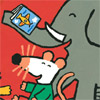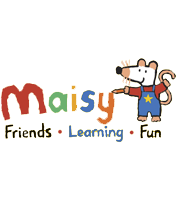 Working with Maisy in the Early Years and the Foundation Stage
Working with Maisy in the Early Years and the Foundation Stage
Young children love Maisy and feel they know her well from enjoying her books and watching her adventures on television at home. This means that most children already share a common understanding and knowledge about Maisy and her friends that teachers can draw upon to provide rich, rewarding and motivating learning experiences within Early Years and Foundation Stage settings.
Developing a repertoire of familiar texts for young readers
Read Maisy aloud: The Maisy books have strong, often humorous storylines that are best read aloud, helping to build young readers’ knowledge of story structure and develop their appreciation of language. They have simple, predictable text that introduces children to new vocabulary through recognizable and familiar situations, often in inventive ways, such as through hidden words and flaps.
Getting children started on reading
Make a Maisy book collection: The Maisy collection includes books to suit all ages and experience. In addition, predictable language combined with familiar everyday storylines gives important support to young children who are beginning to explore their new found reading skills for themselves.
Books like Where is Maisy? turn reading into a game, inviting children to use picture clues to find the answer to questions such as “Is this Maisy’s house?” or “What is Maisy doing?” or, by focussing children’s attention on words hidden under flaps, inviting them to have a go at reading them. Children will want to return to the collection again and again.
Re-playing and retelling stories
Story props: Making story props of the characters encourages children to retell their favourite stories or to create new ones of their own. Put pictures of Maisy, Charley, Tallulah or Cyril onto headbands for children to use in role-play. Turn the role-play area into a scenario within which the class can re-enact their current favourite story.
Talking together
Exploring feelings, fears and anxieties: All of the Maisy stories are about things that interest young children and sharing books together, such as Maisy likes Dancing or Maisy makes Gingerbread, will encourage children to talk about these aspects of their own lives.
In particular, books like Maisy, Charley and the Wobbly Tooth or Maisy Goes to Hospital provide a way for them to explore some of the scarier moments. These can be read aloud as the starting point for an exploratory and reassuring discussion with groups or individuals, and then left for children to revisit later with the confidence that such discussion provides.
Linking sounds and letters
Home made alphabets: Books like Maisy’s ABC and Maisy’s Amazing Big Book of Words offer a useful starting point to demonstrate links between letters and sounds. They also provide a stimulating model for making a class alphabet that uses the names, photos and illustrations of the children. You can also try out Maisy’s ABC and spelling games here.
Writing
Book making: Children will have lots more ideas for Maisy adventures. Act as a scribe to help children write their own big book story about Maisy. Place little home made books in the graphics/writing area for children to use to write their own stories.
Reading and ICT
Web-based Maisy: Make links to electronic versions of some of the Maisy stories – the "turn the page stories" here for example or use the children’s own illustrations to make a Powerpoint edition that they can read on screen or on the whiteboard.
Written by Jane Bunting © 2007 Centre for Literacy in Primary Education. All Rights Reserved







